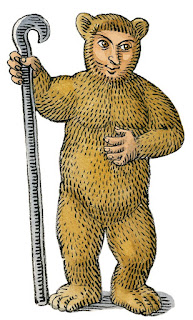The above illustration by the late French artist Jean-Claude Pertuzé is from a version of a folktale known in French as "Jean de l'ours," that is, John of the Bear or John the Bear. The story of a hero, born to a human mother and an ursine father, who is kept in a cave until he is old enough to roll away the stone that encloses it, and who later descends into the underworld to rescue three princesses, the tale was found throughout Europe and has been carried into the Americas. The German philologist Friedrich Panzer traced a series of parallels between the folktale and the saga of Beowulf, whose name may mean "Bee-wolf," that is, "bear."
The classicist Rhys Carpenter went further, connecting the story, by arguments too intricate to describe here, with the Odyssey, and suggesting a common legendary tradition ultimately deriving from memories of a Eurasian bear-cult. The bear, an animal that immures itself and passes the winter in death-like torpor, has often been conceived of as a messenger to the Other World (as among the Ainu), perhaps as their lord himself. Carpenter mentions the case of the bear-like Thracian hero-god Salmoxis, who, according to Herodotus, built a great hall and regaled his guests with promises of eternal life, before disappearing, apparently dead, into an underground chamber for three years, only to return. In Strabo the same figure becomes co-regent of the underworld.
Is it too much to find here an echo in the New Testament, where the stone is rolled away from the tomb of the risen Jesus after the harrowing of Hell?
Subscribe to:
Post Comments (Atom)





No comments:
Post a Comment